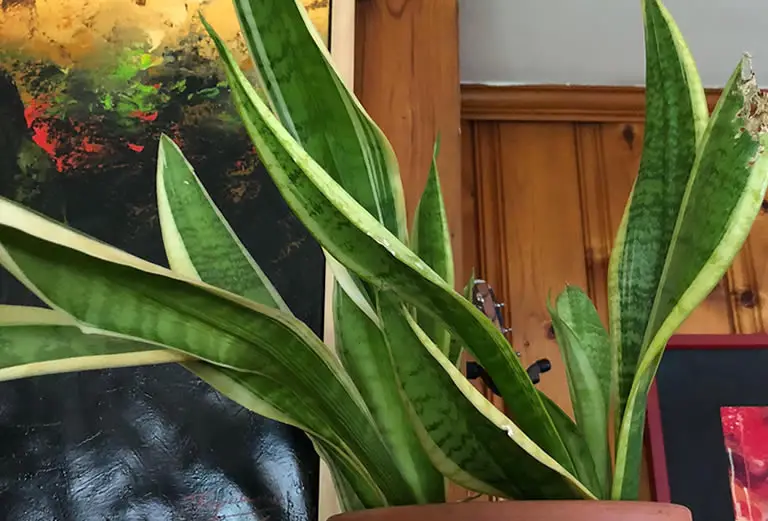There are 6 common causes behind snake plant leaves curling and each has its unique fix. Follow the advice below to identify the source of the plant distress and the appropriate action you need to take to fix your plant an eliminate leaf curl.
Table of Contents
- 6 reasons for snake plant leaves curling & their fixes
- How to identify the cause of your snake plant leaves curling & applying the fix
- 1. Incorrect watering can lead to snake plant leaves curling
- 2. A root-bound root system can lead to snake plant leaves curling
- 3. Temperature issues will often lead to snake plant leaves curling
- 4. Fungal disease can be a cause of snake plant leaves curling
- 5. Lack of sunlight will lead to snake plant leaves curling
- 6. Poor fertilizing habits will cause leaf burn accompanied by leaf curl
6 reasons for snake plant leaves curling & their fixes
One of the trademark qualities of the snake plant are their tall, free-standing, blade-like leaves.
You are obviously here because your snake plant doesn’t look like that, at least not anymore.
If the leaves on your succulent have begun to curl inward, or outward or downward, hiding their beautiful coloration then you will want to take steps to fix the issue.
Let’s start by looking at why this leaf curling is happening to your plant.
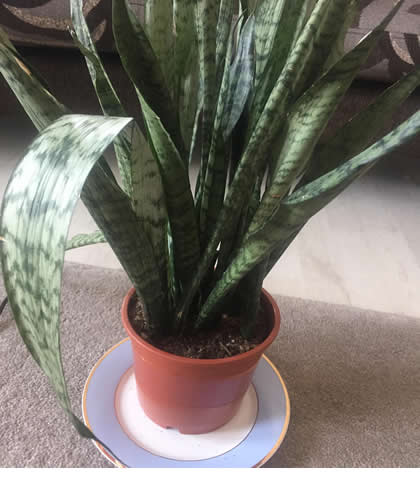 So why are your snake plant leaves curling?
So why are your snake plant leaves curling?
Here’s the 6 common reasons for snake plant leaves curling:
- Underwatering or overwatering.
- Plant is rootbound.
- Temperature issues.
- Fungal diseases.
- Lack of sunlight.
- Poor fertilization habits.
Whether you’re making one or more of the above care mistakes when tending to your snake plant, it’s probably not too late to amend your habits and see the plant make a full recovery.
Ahead, I’ll provide cures for each of the 6 causes of snake plant leaf curling outlined above.
I advise you to read through the entire article to ensure you positively identify the culprit behind your plant’s problem.
You see applying the wrong cure will mean the plant continues to suffer and it may be too late to save it by the time you realise your mistake.
There may also be more than one cause behind your specific plant’s problems.
There is good news though. Once you understand each of the potential causes behind curling leaves on a snake plant it is easy to avoid future potential problems as well.
Let’s get started!
How to identify the cause of your snake plant leaves curling & applying the fix
Before we get into the issues that regularly cause a snake plant’s leaves to curl, it’s a good idea to study the pattern of curling on your specific plant.
The way the leaves curl can be a glimpse into what the issue is, which will help you narrow down the cause of the problem.
Leaves can curl inward, at the leaf margin and then downward, or they can curl upward at the tips, or downward at the tips.
As you will see, the type of curling will usually allow us to clearly define what the cause is.
1. Incorrect watering can lead to snake plant leaves curling
If snake plants are known for one other thing besides their regal leaves, it’s their drought tolerance.
The issue that some beginner indoor gardeners have is they assume drought tolerance means never having to water their snake plants, ever.
Or, they falsely believe that the plant can go months without being watered. This is simply not true.
I have encountered many houseplant owners who use incorrect watering routines for their snake plants.
So much so that I posted a snake plant watering guide on this website outlining how often to water the plant and exactly how to water it.
Just like every other houseplant you own, a snake plant requires water.
It is true that you can get away with watering a snake plant a lot less frequently than most other houseplants, like almost all succulents, but you can’t skip watering a snake plant altogether.
If you do, the plant will dehydrate and its leaves will curl.
Why does this happen?
In a state of dehydration your snake plant is starving for moisture. In an attempt to hold onto whatever moisture it has left, it curls its leaves up tight.
This is where you’ll see downward curling nearer the tips of your snake plant’s leaves.
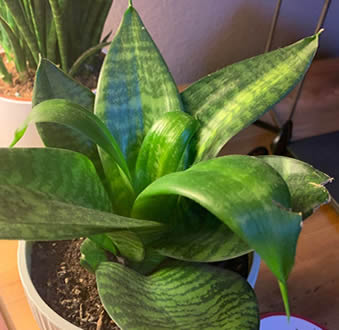
Should you have the opposite problem, where you water your snake plant more often than you should, you can see a similar downward curling of the leaves.
Overwatering can make your Sansevieria’s leaves curl too because both underwatering and overwatering can cause dehydration.
How can a plant become dehydrated by giving it too much water? Well, this is due to a problem known as root rot.
All succulents are very susceptible to root rot because they do not like to sit in water or heavily water-logged soil.
By overwatering a snake plant you force the roots of the plant to sit in water-drenched soil and they slowly begin to rot.
As the roots of a plant rot they become incapable of absorbing moisture and thus are unable to feed water and nutrients to the rest of the plant.
The plant is essentially starved of water even though there is an abundance of it in the soil.
What are the key signs that your snake plant has curling leaves due to dehydration?
When a snake plant is suffering from dehydration you’ll notice downward curling leaves as can be seen in the image above.
You must take steps to determine if the plant is suffering from a lack of water or if it is suffering from root rot due to having been overwatered.
We wrote a great guide about watering snake plants that you should certainly check out (which I linked to above).
The information in there will help you establish a more regular watering schedule that is perfect for maintaining the optimum health of your snake plant.
How to stop snake plant leaves curling due to watering issues
You will usually know if the problem of leaf curling is due to underwatering if you have not been watering your plant enough.
On average a snake plant requires watering once every 3 weeks.
If you have been watering the plant less than this then there is as very high degree of probability that the plant needs to be watered.
But before you run to that water tap be sure to check the soil so you are 100% certain the plant is not suffering from rot root.
Check the soil for moisture.
You usually do this by sticking your index finger into the soil up to the first knuckle.
But, in the case of a curling leaves on a snake plant I suggest you push your finger down much deeper to a point between the first and second knuckle.
What are you looking for?
When you remove your finger from the soil look for soil residue sticking to your finger.
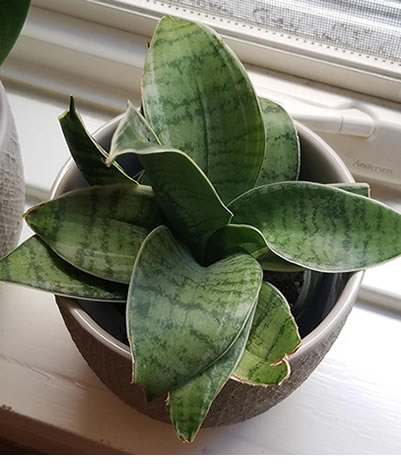 If your finger is clean, or there are bits of dirt that are easily blown away, then the soil is completely dry.
If your finger is clean, or there are bits of dirt that are easily blown away, then the soil is completely dry.
In this case it is likely the plant has been underwatered and needs a good drink of H2O.
If this method is a little unscientific for you and you want a better gauge of the moisture levels in the soil you can always use a very inexpensive soil meter sensor (which is also handy for checking Ph levels in plant soil).
If you remove your finger and there is dirt stuck to it then the soil has enough moisture.
With downward curling leaves and moisture in the soil there is a high likelihood that the plant is suffering from root rot and has been overwatered.
Again, this can be further confirmed by reviewing your watering routine.
Have you been watering the plant more often than once every 3 weeks?
Obviously fixing the problem of underwatering is easy but fixing root rot is a lot more complicated and there is no guarantee your snake plant will even survive after treatment,
However, the steps required to treat root rot are straightforward and fairly easy to complete quickly, so it is worth the effort to try to save the plant.
For a step-by-step guide to treating root rot in succulents read our article Aloe Vera Root Rot Causes And Simple Cure.
The information in that article applies equally as well to snake plant root rot care as both plants are succulents.
In future you will want to allow most of the snake plant’s soil to feel dry to the touch, before you water it.
That will prevent both overwatering and underwatering issues.
2. A root-bound root system can lead to snake plant leaves curling
The snake plant is not a slow grower. If your houseplant is especially happy, then your snake plant could stretch 10 inches in height per year.
Some snake plants even grow 24 inches, which is astounding.
Due to their fast growth, you can’t keep them in the same pot forever.
Once a snake plant outgrows its pot, a lot of negative consequences can occur.
Your plant can’t take in water or nutrients as efficiently, for example.
Most detrimentally, your poor plant can become root bound.
This occurs when the plant’s root system keeps growing and growing but without a bigger home to support the roots they become entangled.
When a snake plant becomes root bound the roots aren’t growing straight out or down any more, but instead they grow in a large spiral around the base of the pot’s interior.
This grow is repeated until there is a mass of intertwined roots.
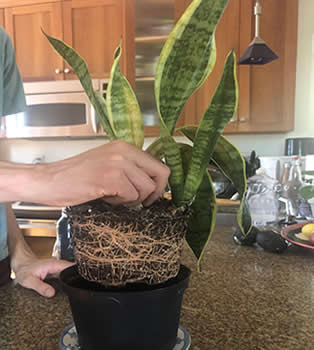
How do you know if your snake plant is root bound?
A root bound houseplant might have roots that visibly emerge from the drainage holes of its pot. Stunted or slow growth is a sign of a root bound snake plant.
Another tell-tale sign that a snake plant is root bound is discoloration in the foliage along with curling leaves.
Your snake plant might also have leaf browning or yellowing, wilting, and slowed growth. Leaf curling will also result.
Notice in the image above how the root bound snake plant has leaves that are starting to curl in on themselves and twist.
How to stop snake plant leaves curling due to rootbound issues
You must remove the root bound snake plant from its pot. However, pulling out a plant from its pot when it has become root bound can sometimes prove to be difficult.
If there are roots protruding from the drainage holes and they are entangled feel free to cut them off.
You might have to smash the pot of a plant that stubbornly refuses to budge from its pot as its better to to break the pot that risk damaging the plant.
This is easily done if it’s ceramic or clay
. For other materials such as plastic, you can cut through the pot with a pair of industrial shears or very sharp scissors.
Once your snake plant is freed, you should be able to see the tangled root system.
If the roots look like one big mass, your snake plant has been rootbound for a long time. You’ll have to prune the root ball using disinfected pruning shears (I use disinfectant wipes).
Cut away about 1 third of the impacted soil at the base with a disinfected knife.
If the problem is very bad (like the plant in the image above) don’t be afraid to cut away half of the impacted soil.
Then using fresh soil repot your snake plant in either a bigger pot to encourage more growth or its original size pot if you want to to maintain its current size.
About once a year, upgrade its pot to an even bigger one or prune its roots back if you want to keep it in the same pot and at the same size.
3. Temperature issues will often lead to snake plant leaves curling
What kind of environment are you keeping the snake plant in? You might assume that because you’re growing the plant indoors that it’s fine in just about any location, but this is not true.
The snake plant is not very cold-tolerant. When temperatures decrease to 50° Fahrenheit, this plant will begin exhibiting cold stress. The leaves will wilt, curl, and turn yellow.
When cold stress becomes more severe, necrosis of the tissue can occur.
Snake plants don’t like too much heat either though.
Once the temperature soars past 85° F, your snake plant will show you it’s unhappy with leaf tips that are curled upward.
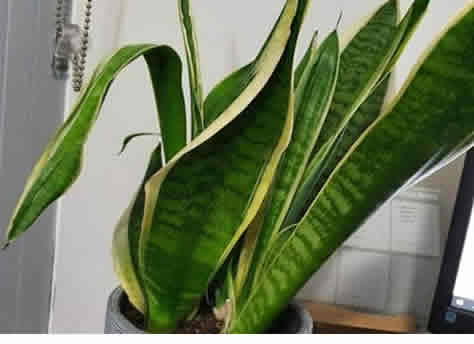
Incorrect humidity levels can also cause this type of leaf curling.
Unlike some other succulents, snake plants don’t have high humidity requirements, preferring normal humidity levels found in the average American home.
So if the air is too moist, or too dry, the plant’s leaves will begin to curl.
How to stop snake plant leaves curling due to temperature issues
First thing’s first, and that’s to check your thermostat. The snake plant prefers temps between 55° and 85° Fahrenheit.
That’s a range of 30 degrees, and any temperatures within that range are fine for the Sansevieria.
Luckily, most homes in America (and most of the Western world) are kept at a regular 70°F.
As we always say on the blog, watch your heat and cold sources. Your snake plant should be far enough away from a drafty window or door, your refrigerator and freezer, and any vents.
The cold and warm air that comes from these sources is enough to make the plant’s leaves curl.
Next, test the humidity levels around the plant.
Snake plants need humidity at only 40 percent, which is on the higher end of the spectrum of average relative humidity.
In other words, you shouldn’t have to do anything special for this plant’s humidity requirements as your home will almost certainly fall into an acceptable humidity range for this succulent.
If you are a regular reader of my website then you will know that I just love using terracotta pots for succulents.
Not only does terracotta look fantastic with these type of plants but its unique composition means that it sweats moisture from the soil to the outside of the pot.
This is great for helping reduce water-retention in the soil (which we have seen is bad for succulents) but it also increases the humidity levels in the localized environment directly around the plant, as the sweated moisture evaporates from the outside of the pot.
This increase in humidity that comes with using terracotta pots is why I do not use terracotta with snake plants.
It is much better to use ceramic pots with snake plants as they will not increase the humidity levels around the plant. You can of course use plastic but I think ceramic looks much better.
4. Fungal disease can be a cause of snake plant leaves curling
Fungi can spread easily once a plant is infected. Granted, it happens a lot more with outdoor plants than indoor ones, but both types are at risk.
So, this includes your snake plant, especially if it’s in proximity to an affected plant.
Two types of fungal diseases are known to make the plant’s leaves curl.
The first disease is southern blight, which thrives in moist conditions such as high humidity in warm summer weather.
A snake plant with southern blight will begin to wilt and display curled leaves. The lower part of the leaves might become patchy and discolored in hues like brown or yellow.
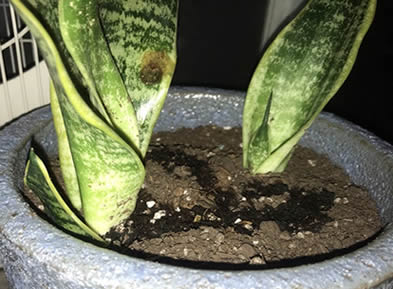
Eventually, the entire plant can collapse, and at that point, your poor snake plant is likely done for.
So, as soon as you see signs of fungal infection you should take immediate action.
The second fungal disease that can curl a snake plant’s leaves is red leaf spot.
This condition easier to visibly detect, as an infected plant will develop red circular spots throughout the foliage, especially on the upper sides of the leaves (see this image).
Under the leaves you will often see white spots that are powdery in texture (see this image).
How to stop snake plant leaves curling due to fungal diseases
After identifying the fungal disease, you must rid your snake plant of it.
To treat southern blight, take your snake plant out of its pot and then lay out its soil on a tarp.
Giving the plant good levels of sun exposure, which is known as solarization, can increase the temperature to 122 degrees and kill the fungus that causes southern blight.
That said, you need hours of consistent sunlight and ideally a warm environment for solarization to work.
If solarizing didn’t help, then you’re going to have to throw away your snake plant and start anew.
You could try using a fungicide but this is not guaranteed to work on southern blight though I would give it a go along with solarization.
Luckily it is much easier to treat red leaf spot.
You’d need a systemic fungicide to stop the red leaf spot.
Apply it according to the product instructions and you should see a quick recovery in your plant.
You will also need to take steps in order to prevent future recurrences of the fungi that cause these diseases.
Watering on a schedule will help, and regularly applying a preventative fungicide is also in the best interest of your indoor garden.
Always aim to keep the snake plant’s leaves dry when watering the plant, especially if red leaf spot has been an issue in the past.
The best way of watering your snake plant then is from the bottom avoiding using a can or spray.
5. Lack of sunlight will lead to snake plant leaves curling
Another common misconception about the snake plant is that in bright light, low light, or no light, this plant will be fine.
That’d be great if it were the case, but of course, it isn’t.
All houseplants need light even if some need more or less than others.
Ideally, natural sunlight is best, but good quality artificial lights can be a great help for struggling plants and for snake plants that live in somewhat gloomy surroundings.
In very dim conditions, your snake plant will begin to grow slanted and angle itself towards whatever paltry light source it has. Its leaves can curl in that direction as well.
How to stop snake plant leaves curling due to insufficient light
Snake plants do best in bright, indirect light about 10 feet away from a southerly-facing or westerly-facing window.
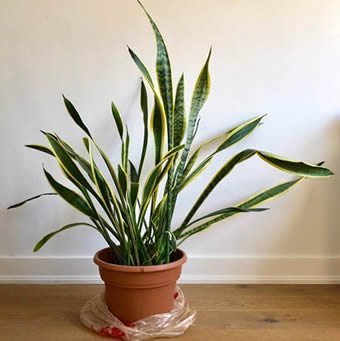
Some time in the shade is okay, and even a short period of prolonged dimness won’t kill the Sansevieria, but too much darkness is not good for your plant.
It’s a succulent and succulents love light.
Bright sunlight is equally as detrimental however, although it won’t cause leaf curling it will burn the leaves.
Too much sun can scorch your snake plant’s blade-like leaves and so placing the plant somewhere that gets really good indirect light is advisable.
6. Poor fertilizing habits will cause leaf burn accompanied by leaf curl
Have you noticed that your snake plant’s leaves have curled inward? As we said at the start of this guide, that’s indicative of a lack of nutrients.
Namely, your houseplant doesn’t have enough nitrogen.
Houseplants of all species need nitrogen, as it allows for RNA and DNA nucleic acids to populate.
The nucleic acids, including amino acids, encourage houseplants to develop proteins for cellular growth.
Further, nitrogen is a crucial part of chlorophyll production.
Chlorophyll is an ingredient in the plant process of photosynthesis.
Without photosynthesis, a plant can’t generate water and sugar from carbon dioxide for energy.
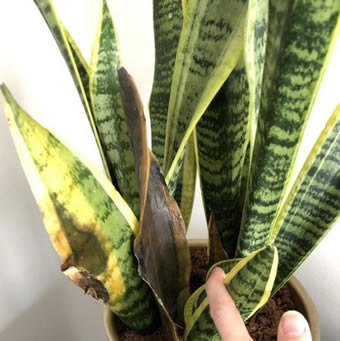
As well as nitrogen, houseplants also need phosphorus and potassium, the other two of the three major plant macronutrients.
Phosphorus benefits photosynthesis too, enabling a plant to take energy from the sun and grow from it.
Potassium activates enzymes that affect adenosine triphosphate or ATP, starch, and protein production.
A plant is more drought-resistant thanks to how much potassium it has, and roots grow more strongly in plants that are fed potassium.
How to stop snake plant leaves curling due to incorrect fertilization
Snake plants require fertilizing only twice per year. The first feeding of fertilizer should occur in the spring, and the second in the summer when the plant is actively growing.
Be sure to use an appropriate fertilizer that is formulated to give your snake plant all the essentials it needs.
Standard feeds seldom work well for all houseplants.
Once you get your snake plant on a more regular fertilizer schedule, the side effects of its nutrient deficiencies should vanish.
That said, please don’t fertilize the snake plant more than it needs in an attempt to get its leaves to unfurl.
Too much fertilizer can stunt growth, cause discoloration, and make the plant shed leaves.

